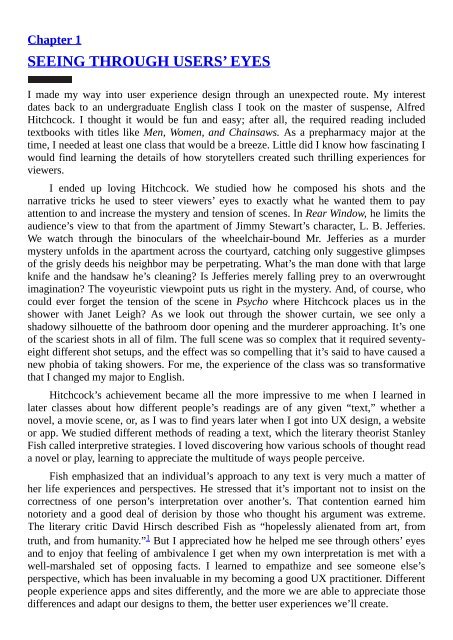Create successful ePaper yourself
Turn your PDF publications into a flip-book with our unique Google optimized e-Paper software.
Chapter 1<br />
SEEING THROUGH USERS’ EYES<br />
I made my way into user experience design through an unexpected route. My interest<br />
dates back to an undergraduate English class I took on the master of suspense, Alfred<br />
Hitchcock. I thought it would be fun and easy; after all, the required reading included<br />
textbooks with titles like Men, Women, and Chainsaws. As a prepharmacy major at the<br />
time, I needed at least one class that would be a breeze. Little did I know how fascinating I<br />
would find learning the details of how storytellers created such thrilling experiences for<br />
viewers.<br />
I ended up loving Hitchcock. We studied how he composed his shots and the<br />
narrative tricks he used to steer viewers’ eyes to exactly what he wanted them to pay<br />
attention to and increase the mystery and tension of scenes. In Rear Window, he limits the<br />
audience’s view to that from the apartment of Jimmy Stewart’s character, L. B. Jefferies.<br />
We watch through the binoculars of the wheelchair-bound Mr. Jefferies as a murder<br />
mystery unfolds in the apartment across the courtyard, catching only suggestive glimpses<br />
of the grisly deeds his neighbor may be perpetrating. What’s the man done with that large<br />
knife and the handsaw he’s cleaning? Is Jefferies merely falling prey to an overwrought<br />
imagination? The voyeuristic viewpoint puts us right in the mystery. And, of course, who<br />
could ever forget the tension of the scene in Psycho where Hitchcock places us in the<br />
shower with Janet Leigh? As we look out through the shower curtain, we see only a<br />
shadowy silhouette of the bathroom door opening and the murderer approaching. It’s one<br />
of the scariest shots in all of film. The full scene was so complex that it required seventyeight<br />
different shot setups, and the effect was so compelling that it’s said to have caused a<br />
new phobia of taking showers. For me, the experience of the class was so transformative<br />
that I changed my major to English.<br />
Hitchcock’s achievement became all the more impressive to me when I learned in<br />
later classes about how different people’s readings are of any given “text,” whether a<br />
novel, a movie scene, or, as I was to find years later when I got into UX design, a website<br />
or app. We studied different methods of reading a text, which the literary theorist Stanley<br />
Fish called interpretive strategies. I loved discovering how various schools of thought read<br />
a novel or play, learning to appreciate the multitude of ways people perceive.<br />
Fish emphasized that an individual’s approach to any text is very much a matter of<br />
her life experiences and perspectives. He stressed that it’s important not to insist on the<br />
correctness of one person’s interpretation over another’s. That contention earned him<br />
notoriety and a good deal of derision by those who thought his argument was extreme.<br />
The literary critic David Hirsch described Fish as “hopelessly alienated from art, from<br />
truth, and from humanity.” 1 But I appreciated how he helped me see through others’ eyes<br />
and to enjoy that feeling of ambivalence I get when my own interpretation is met with a<br />
well-marshaled set of opposing facts. I learned to empathize and see someone else’s<br />
perspective, which has been invaluable in my becoming a good UX practitioner. Different<br />
people experience apps and sites differently, and the more we are able to appreciate those<br />
differences and adapt our designs to them, the better user experiences we’ll create.


